JUNE QUARTER KEY FIGURES
 | Mar Qtr 04 to Jun Qtr 04 | Jun Qtr 03 to Jun Qtr 04 |
| STAGE OF PRODUCTION | % change | % change |
|
| Final (Stage 3) commodities (excl. exports) | 1.1 | 2.3 |
| Domestic | 0.8 | 4.4 |
| Imports | 2.3 | -7.6 |
| Intermediate (Stage 2) commodities | 1.4 | 0.4 |
| Domestic | 0.8 | 1.4 |
| Imports | 6.1 | -5.4 |
| Preliminary (Stage 1) commodities | 1.9 | 1.0 |
| Domestic | 1.2 | 1.7 |
| Imports | 8.3 | -3.0 |
|
Final Stage, Base: 1998-99 = 100.0
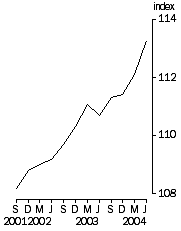
| Final Stage, Quarterly % change

|
JUNE QUARTER KEY POINTS
FINAL (STAGE 3) COMMODITIES
- The final (Stage 3) index rose 1.1% in the June quarter 2004.
- The final (Stage 3) domestic index rose 0.8%, mainly due to increases in prices of building construction and petroleum refining, which were partially offset by price falls in other agricultural products and motor vehicles and parts.
- The final (Stage 3) imports index rose 2.3%, due to exchange rate driven prices increases for both consumer and capital goods, including industrial machinery and equipment, refined petroleum products and a range of manufactured goods.
INTERMEDIATE (STAGE 2) COMMODITIES
- The intermediate (Stage 2) index rose 1.4% in the June quarter 2004.
- The intermediate (Stage 2) domestic index rose 0.8%, mainly due to increases in iron and steel products, refined petroleum products, oil and gas extraction and basic non-ferrous metals.
- The intermediate (Stage 2) imports index rose 6.1%, due to exchange-rate driven price increases for oil and gas extraction, basic chemicals, iron and steel products and refined petroleum products.
PRELIMINARY (STAGE 1) COMMODITIES
- The preliminary (Stage 1) index rose 1.9% in the June quarter 2004.
- The preliminary (Stage 1) domestic index rose 1.2% mainly due to price increases in basic ferrous and non-ferrous metals, oil and gas extraction and refined petroleum products. These increases were partly offset by lower prices for electricity, gas and water supply.
- The preliminary (Stage 1) imports index rose 8.3% mainly due to exchange-rate driven increases of imports including oil and gas extraction, basic chemicals and iron and steel products.
NOTES
CHANGES IN NEXT ISSUE
June quarter 2004 is the last quarter that the ABS will be compiling the Price Index of Materials Used in Building Other than House Building. This data appears in Tables 19 and 20 of this publication and in the electronic Tables 33 - 42 on the ABS web site. Users of this index, who are interested in discussing alternative indicators of price changes for these commodities, can contact Steve Whennan on Canberra (02) 6252 6251, or email <steve.whennan@abs.gov.au>.
RELATED STATISTICS
For more information about statistics in this publication and about other 'ABS data available on request', contact Steve Whennan on Canberra (02) 6252 6251, or email <steve.whennan@abs.gov.au>.
INQUIRIES
For further information about these and related statistics, contact the National Information and Referral Service on 1300 135 070 or Steve Whennan on Canberra (02) 6252 6251.
SUMMARY COMMENTARY
COMMENTARY
STAGE OF PRODUCTION OVERVIEW
Each of the three stage of production indexes increased in the June quarter 2004, with the preliminary (Stage 1) index showing the largest rise of 1.9%, followed by an increase of 1.4% for the intermediate (Stage 2) index and a 1.1% increase for the final (Stage 3) index. Through the year to June quarter 2004, the final (Stage 3) index increased by 2.3%, followed by an increase of 1.0% for the preliminary (Stage 1) index and a 0.4% increase for the intermediate (Stage 2) index.
The depreciation of the Australian dollar against the US dollar in the June quarter 2004 has been a significant contributor to the increase in all three stage of production indexes. Further, the global increase in crude oil prices has impacted on all these indexes, extending beyond oil and gas extraction and production of petroleum products to affect other commodities which either directly, or indirectly, utilise crude oil as a component in the production process. A similar impact can be observed from iron and steel, with increasing global demand exerting upward pressure on iron and steel prices, as well as related industries.
The domestic final commodities index rose 0.8% as a result of increases for building construction and petroleum refining, which were partially offset by decreases for other agriculture and motor vehicles and parts. The imports final commodities index rose 2.3% due to increases for industrial machinery and equipment, petroleum refining and other transport equipment. Price rises were additionally observed for a wide range of imported manufactured goods, primarily driven by the depreciation of the Australian dollar against most major currencies. This increase was partially offset by price falls for imports of photographic and scientific equipment.
The intermediate (Stage 2) index increased by 1.4% due to price rises for imports of oil and gas, basic chemicals, iron and steel and refined petroleum. Price rises were also observed for domestically produced iron and steel, petroleum, oil and gas and basic non ferrous metals.
The preliminary (Stage 1) index increased by 1.9% due to price rises for imports of oil and gas, basic chemicals and iron and steel. Domestically produced iron and steel, oil and gas and petroleum products also contributed to the increase in this index.
COMPARISON OF SOP INDEXES

MANUFACTURING INDUSTRIES PRODUCER PRICE INDEXES
During the June quarter 2004, the input prices for manufacturing industries increased by 2.7%. The output prices for manufacturing industries increased by 1.9% during the same period. Depreciation of the Australian dollar against the US dollar and other major currencies had a strong impact on the results for both the input and output indexes. The input price index decreased by -2.3% through the year to June quarter 2004 and the output price index increased by 2.8% during the same period.
Increases in the price of crude oil (both imported and domestic), whole milk products, copper oxides and wheat and meslin were the main contributors to the quarterly result for the materials used in manufacturing industries index. Price decreases for cattle and calves, sheep and lambs and pigs provided some offsets to these increases. Higher prices for petroleum products, alumina and basic iron and steel manufacturing contributed to the bulk of the increase in the articles produced by manufacturing industries index for the June quarter 2004. These increases were partially offset by decreases in prices for beef and motor vehicles.
ARTICLES PRODUCED BY MANUFACTURING INDUSTRIES: All Groups, Quarterly % change
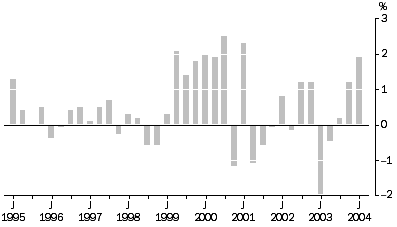
MATERIALS USED IN MANUFACTURING INDUSTRIES: All Groups, Quarterly % change
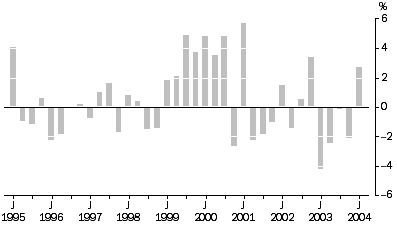
CONSTRUCTION INDUSTRIES PRODUCER PRICE INDEXES
The price indexes for materials used in house building and materials used in building other than house building increased by 1.3% and 3.0%, respectively, in the June quarter 2004.
Ready mixed concrete, reinforcing steel, clay bricks and concrete tiles were the most significant contributors to the increase observed for the materials used in house building price index. There were no significant offsetting price decreases for this index.
Structural steel, reinforcing steel bar, ready mixed concrete and mains cable were the largest contributors to the increase in the index of materials used in building other than house building. There were no significant offsetting price decreases for this index.
Through the year to June quarter 2004, the materials used in house building index rose 3.0%, compared with an increase of 4.0% for the index of materials used in building other than house building.
All state capital city indexes recorded increases for the materials used in house building price index in the June quarter 2004, ranging from 1.0% in Melbourne and Perth to 1.8% in Brisbane. All state capital city indexes also recorded increases in the June quarter 2004 for the materials used in building other than house building price index, ranging from 2.4% in Hobart to 3.4% in Brisbane and Perth.
Materials Used in House Building: All Groups, Quarterly % change

MATERIALS USED IN BUILDING OTHER THAN HOUSE BUILDING: All Groups, Quarterly % Change
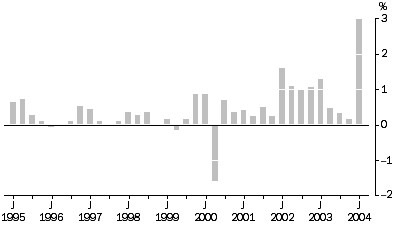
The price index for the output of the general construction industry increased by 2.1% in the June quarter 2004 and by 7.9% through the year ending June quarter 2004. Increases were registered across the quarter for all component industries, with the index for non-residential building construction being the largest contributor, followed by house construction and residential building construction other than houses. Contributing to the movement in the general construction industry price indexes this quarter were increases in the cost of material, labour and plant inputs. The increase in labour costs was mainly due to continuing high demand for building trades and shortages of skilled labour.
OUTPUT OF THE GENERAL CONSTRUCTION INDUSTRY: All Groups, Quarterly % change
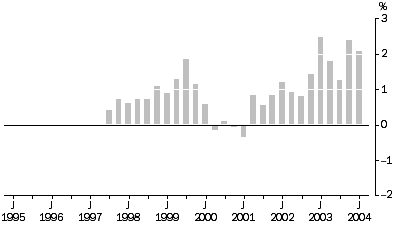
SERVICE INDUSTRIES PRODUCER PRICE INDEXES
The property and business services industries price index increased by 0.3% in the June quarter 2004 and by 3.5% through the year ending June quarter 2004. The property services price index increased by 0.9% this quarter with increases for real estate agents and commercial property operators. There were no significant price decreases for this index.
PROPERTY AND BUSINESS SERVCIES INDUSTRIES: All Groups, Quarterly % change
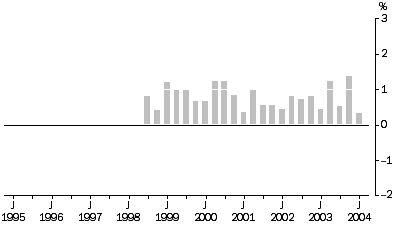
The business services index rose 0.1% in the June quarter 2004 and by 3.2% through the year ending June quarter 2004. The main contributors to the upwards movement were contract staff services, legal services and consultant engineering services. Large offsetting price decreases for advertising services, accounting services and business management services were observed for this index.
The transport (freight) and storage industries index recorded no change in the June quarter 2004 and an increase of 1.4% through the year ending June quarter 2004. The most significant price increases in the June quarter 2004 were customs agents services and road freight transport. The most significant price decreases were observed for international air transport and rail transport.
TRANSPORT (FREIGHT) AND STORAGE INDUSTRIES: All Groups, Quarterly % change
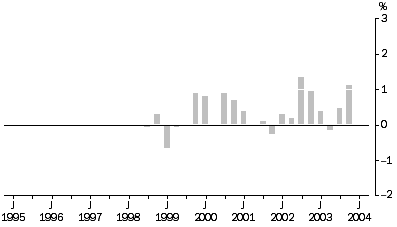
 Print Page
Print Page
 Print All
Print All